<< Previous | Displaying results 5476-5500 of 6769 for "" | Next >>
Insignia of the 99th Infantry Division. The 99th Infantry Division, the "Checkerboard" division, gained its nickname from the division's insignia. The insignia was devised upon the 99th's formation in 1942, when the division was headquartered in the city of Pittsburgh. The blue and white checkerboard in the division's insignia is taken from the coat of arms of William Pitt, for whom Pittsburgh is named. The division was also known as the "Battle Babies" during 1945, a sobriquet coined by a United Press…
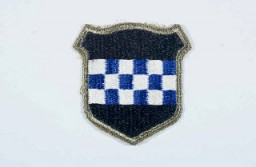
Insignia of the 103rd Infantry Division. The 103rd Infantry Division, the "Cactus" division, is so called after the 103rd's shoulder patch, a cactus in a gold circle. The cactus is representative of the states whose troops formed the unit in the early 1920s: Arizona, Colorado, and New Mexico.

Insignia of the 104th Infantry Division. The nickname of the 104th Infantry Division, "Timberwolf," originated from the division's insignia, a gray timberwolf. The timberwolf, native to the Pacific Northwest, was chosen as representative of the area where the division was formed in 1942.
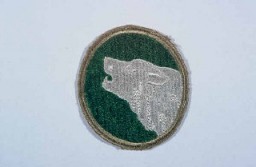
Insignia of the 63rd Infantry Division. The 63rd Infantry Division was nicknamed the "Blood and Fire" division soon after its formation in the spring of 1943. The nickname commemorates British prime minister Winston Churchill's statement at the Casablanca Conference in January 1943 that "the enemy would bleed and burn in expiation of their crimes against humanity." The divisional insignia illustrates the nickname.
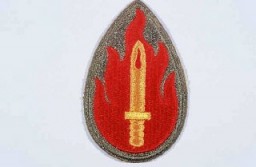
US troops with the 102nd Infantry Division at a barn outside Gardelegen, where over 1,000 prisoners were burned alive by the SS. Germany, April 14, 1945.
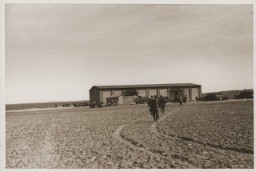
American troops inspect the site of the Gardelegen atrocity. In the background, German civilians exhume corpses who were buried in a mass grave by the SS. Germany, April 18, 1945.
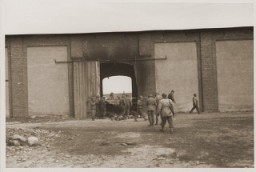
An American tank follows German civilians from Gardelegen who are marching to a barn just outside the town, where they will dig graves for over 1,000 prisoners killed by the SS inside the barn. April 18, 1945.

An American medic and soldier stand by the corpse of a prisoner shot on the road near Gardelegen. The prisoner was shot by the SS when he was too exhausted to continue on a death march. Germany, April 14-18, 1945.
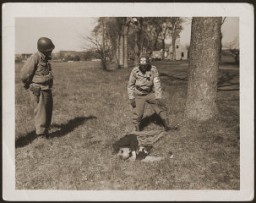
Insignia of the 3rd Armored Division. "Spearhead" was adopted as the nickname of the 3rd Armored Division in recognition of the division's role as the "spearhead" of many attacks during the liberation of France in 1944.

Insignia of the 82nd Airborne Division. The nickname for the 82nd Airborne Division originated in World War I, signifying the "All American" composition of its members. The troops who formed the division came from diverse areas of the United States.
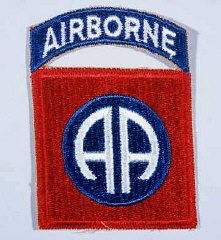
A chaplain with the 82nd Airborne Division helps a survivor board a truck that will evacuate him from the Wöbbelin concentration camp to an American field hospital. Germany, May 4, 1945.
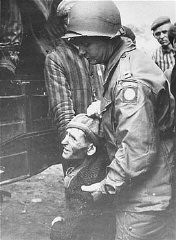
The fenced perimeter and an entrance to the women's camp at Wöbbelin. Photograph taken May 4–6, 1945.
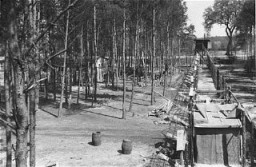
US troops with the 82nd Airborne Division look on as Germans are forced to exhume corpses from a mass grave. Wöbbelin, Germany, May 6, 1945.
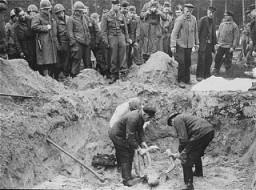
After the liberation of the Wöbbelin camp, US troops forced the townspeople of Ludwigslust to bury the bodies of prisoners killed in the camp. This photograph shows American troops at the funeral service for the victims. Germany, May 7, 1945.
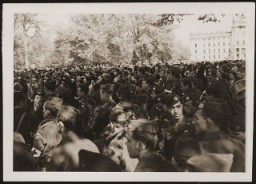
Survivors waiting for to be evacuated from the Wöbbelin concentration camp to receive medical attention at a field hospital. Germany, May 4, 1945.
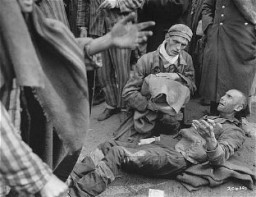
Survivors in Wöbbelin board trucks for evacuation from the camp to an American field hospital for medical attention. Germany, May 4–5, 1945.
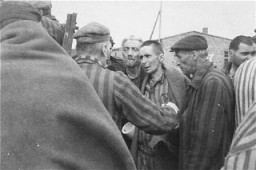
A US Army soldier views the bodies of prisoners piled on top of one another in the doorway of a barracks in Wöbbelin. Germany, May 4–5, 1945.
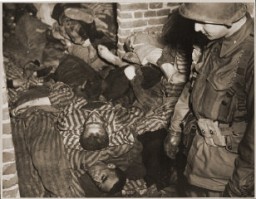
The crematorium building at the Flossenbürg concentration camp. Flossenbürg, Germany, May 1945.
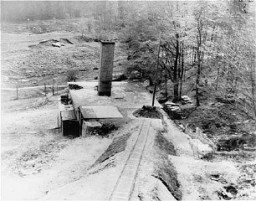
A counterfeit British bank note produced by Jewish forced laborers employed in Operation Bernhard at the Sachsenhausen concentration camp. Under an order issued by SS chief Heinrich Himmler in 1942, Operation Bernhard initially aimed to produce large quantities of counterfeit British bank notes. The goal was to flood the British currency market and trigger a financial crisis.
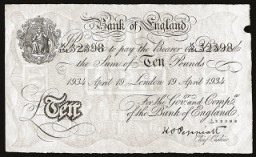
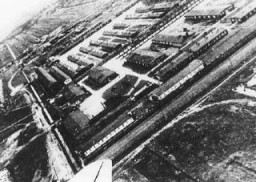
An SS guard watches prisoner laborers at construction work. Neuengamme concentration camp, Germany, wartime.
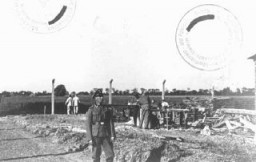
Concentration camp prisoners, many from satellite camps of Neuengamme, remove corpses of German civilians after Allied bombings of Hamburg. Germany, August 1943.
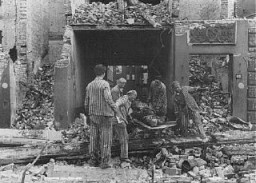
SS men supervise laborers at construction work. Neuengamme concentration camp, Germany, winter 1943.
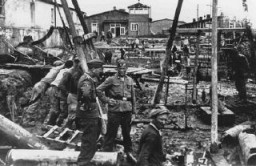
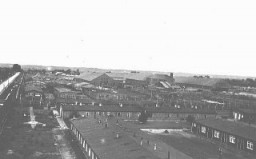
A Jewish child is forced to show the scar left after SS physicians removed his lymph nodes. This child was one of 20 Jewish children injected with tuberculosis germs as part of a medical experiment. All were murdered on April 20, 1945. Neuengamme concentration camp, Germany, between December 1944 and February 1945.
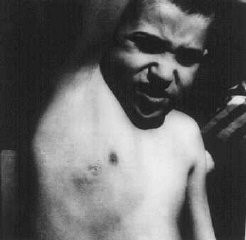
We would like to thank Crown Family Philanthropies, Abe and Ida Cooper Foundation, the Claims Conference, EVZ, and BMF for supporting the ongoing work to create content and resources for the Holocaust Encyclopedia. View the list of donor acknowledgement.